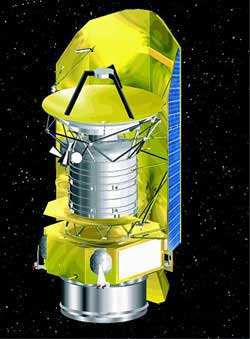Herschel Space Observatory facts for kids
Quick facts for kids Herschel Space Observatory |
|
 |
|
| Organization | European Space Agency (ESA) NASA |
|---|---|
| Location | Lagrangian point L2 |
| Wavelength | 60-670 µm (far-infrared) |
| Telescope style | Ritchey-Chrétien |
| Diameter | 3,500 mm (140 in), f/0.5 (Primary Mirror) |
| Collecting area | 9.6 m2 (103 sq ft) |
| Focal length | 28.5 m (94 ft), f/8.7 |
| Website | herschel.esac.esa.int |
The Herschel Space Observatory was a special space telescope. It was the largest infrared telescope ever launched into space. The European Space Agency (ESA) built and operated it.
This observatory was named after Sir William Herschel. He was a famous astronomer who discovered infrared light. He also found double stars and the planet Uranus.
Herschel could "see" very cold and dusty objects in space. It looked at light in the far-infrared and sub-millimetre range. This light is invisible to human eyes. The telescope had a large mirror, about 3.5 meters (11.5 feet) wide.
Contents
Journey to Space
The Herschel Space Observatory launched in May 2009. It traveled aboard an Ariane 5 rocket. The launch happened from the Guiana Space Centre in French Guiana.
Where Herschel Lived in Space
Herschel went to a special spot called the second Lagrangian point (L2). This point is about 1.5 million kilometers (930,000 miles) away from Earth. At L2, the gravity from the Earth and Sun balances out. This allowed Herschel to stay in a stable orbit.
What Herschel Studied
Herschel was like a detective for the universe. It helped scientists understand many things. The telescope could see through thick dust clouds in space. This allowed it to find objects that other telescopes could not.
Searching for New Stars and Galaxies
One of Herschel's main goals was to study how galaxies formed. It looked at very old galaxies that were just starting to grow. It also studied how stars are born. Stars form from giant clouds of gas and dust. Herschel helped us see inside these dusty nurseries.
Exploring Our Solar System
Herschel also looked closer to home. It studied the chemical makeup of atmospheres and surfaces. This included planets, comets, and moons in our own Solar System.
Understanding Space Chemistry
Another important task was to learn about molecular chemistry. This means studying the different chemicals found throughout the universe. Herschel helped us understand how these chemicals interact in space.
Partnership and Importance
The United States, through NASA, worked with ESA on this project. Herschel was a very important mission for ESA. It was one of their four "cornerstone" science missions. The others were Rosetta, Planck, and the Gaia mission.
Images for kids
-
Animation of Herschel Space Observatory's trajectory from 14 May 2009 to 31 August 2013 Herschel Space Observatory · Earth
-
Animation of Herschel Space Observatory's trajectory around Earth from 14 May 2009 to 31 December 2049 Herschel Space Observatory · Earth
See also
 In Spanish: Herschel (observatorio espacial) para niños
In Spanish: Herschel (observatorio espacial) para niños







